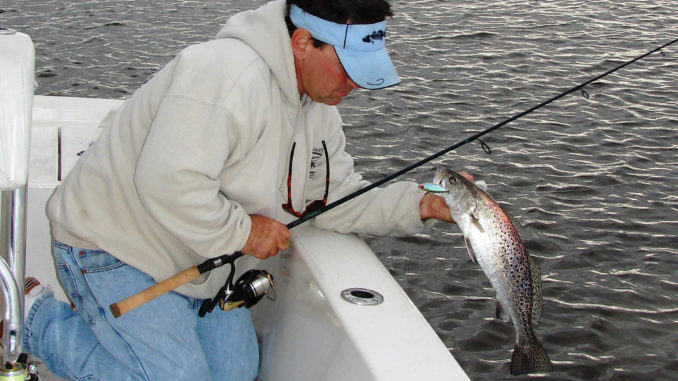
North Carolina fishermen will see their daily creel limit in coastal waters for speckled trout drop from 10 to six per day and the size restrictions increased as of Tuesday (Nov. 30, 2010), as the North Carolina Division of Marine Fisheries seeks to reduce the annual harvest of the popular saltwater fish and strengthen the population.
In addition to the change in the creel limit, the size minimum was raised from 12 to 14 inches, with only two fish longer than 24 inches allowed per day.
The DMF voted on Nov. 5, and then again on Nov. 23, for new regulations that is designed to reduce the catch by 28 1/2 percent as required by the Spotted Sea Trout Fisheries Management Plan.
The changes will take effect at 12:01 a.m. Tuesday (Nov. 30). The proclamation issued yesterday (Nov. 23) also addresses commercial fishing, with a year-round moratorium on commercial possession and sale of speckled trout on weekends taking effect on the same day.
The North Carolina Wildlife Resources Commission, which manages fisheries in inland waters, voted to keep the daily creel limit inland at 10 specks per day but, as of Aug. 1, 2011, the minimum size will increase to 14 inches.
The recreational changes were agreed upon by North Carolina Marine Fisheries Commission members during their first vote, but getting the commercial restrictions in place took several weeks.
At a Nov. 3-5 meeting in New Bern, MFC members discussed, approved, re-discussed and re-approved a closure of commercial fishing for speckled trout from Dec. 15-Feb. 28 annually, a move that DMF staff said would meet the 28.5-percent harvest reduction requirement.
However, holders of commercial seats on the Commission, plus the holder of one recreational seat, asked to re-visit the commercial restriction at a special meeting on Nov. 22 in Morehead City. Apparently, the Dec. 15-Feb. 28 closure met with disapproval from rank-and-file commercial fishermen, who asked their representatives to find another way to reduce the harvest.
At the Morehead City meeting, the 10-week closure was rescinded and a year-round weekend closure was put in its place.
Rob Bizzell, the chairman of the MFC, responded to concerns that the weekend closure does not prohibit commercial fishermen from fishing on weekends – it just prohibits them from possessing or selling specks on the weekends.
Under the new regs, trout that are caught in nets on the weekends can be harvested and sold after midnight on Sundays, and those that are in poor condition can be discarded without penalty.
“Beth Burns is our lead biologist on the spotted seatrout team, and we questioned her about this,” Bizzell said. “She said these measures would work to meet the required reduction, and we accepted her findings.”
He went on to say that the provision allowing trout caught in nets to be kept and sold after midnight on Sundays would simply prevent waste.
“We need to allow the commercial fishermen to fish for other species on the weekends, so there really was no way to require removing the gear from the water,” Bizzell said. “Trout do not survive well in nets and begin deteriorating almost immediately.
“We were assured fishermen would not want to waste time picking trout they couldn’t sell from their nets, and they would not intentionally set on weekends in trout-rich waters.”
Bizzell added that this plan will be reviewed more quickly than normal.
“Normal review time for a fishery management plan is five years, but as a special consideration, this FMP will be reviewed in three years to be sure it is working,” he said.
As far as the recreational changes, Bizzell again pointed to Burns’ findings that the new measures will would protect specks.
“(Burns) also said raising the minimum size to 14 inches would ensure the trout spawn once, and maybe even twice, before they can be removed from the population, and this would help immensely,” Bizzell explained. “They had only rarely spawned with the previous 12-inch minimum size.”
The MFC also addressed the possibility of reopening commercial fishing for menhaden in state waters (out to three miles) south of Cape Lookout, but by a 4-3 vote, the current closure was sustained.
Not everyone was please with the new recreational and commercial regulations.
Chris Elkins, president of CCA-North Carolina, said the MFC was actually operating on a fisheries management plan that wasn’t what was needed and wasn’t legal.
“This FMP amendment does not meet the requirements of Session Law 2010-13 that was passed in June,” Elkins said. “The Commission has requested another law to allow circumventing the law on this amendment.
“DMF biologists say the reductions to allow this amendment to meet SL 2010-13 would need to be 57 percent across the board, and this is only half of that.”
Elkins said the bar should be set much higher.
“We want the Commission to follow SL 2010-13 and adopt an FMP that will end overfishing in two years and rebuild the fishery to viable in 10 years,” he said. “DMF biologists have said a two-fish recreational limit, with a 14-inch minimum size and a 50-pound trip limit for commercial fishermen would do this.”




Be the first to comment